VERY RARE! WWII June 8th 1944 D-Day +2 Normandy Original Combat Invasion Report USS Minneapolis

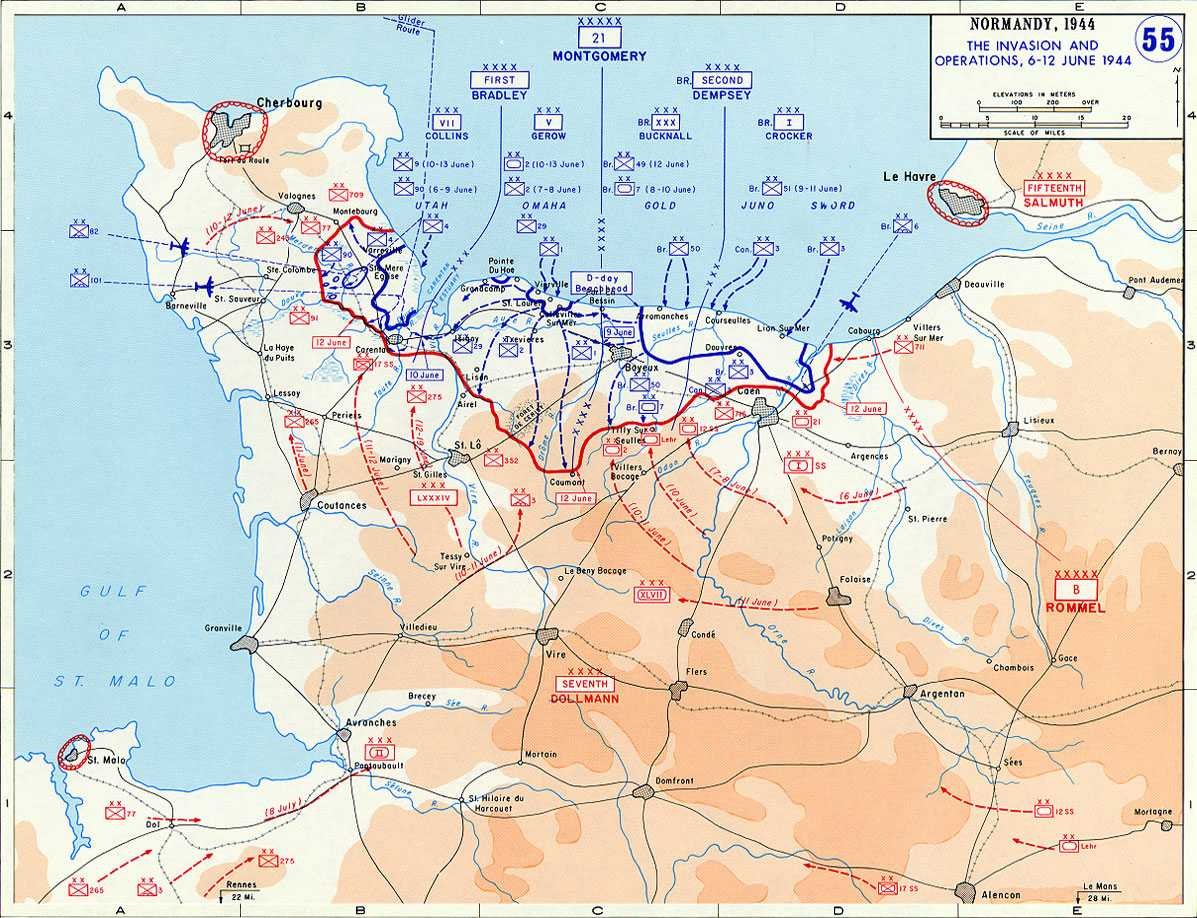


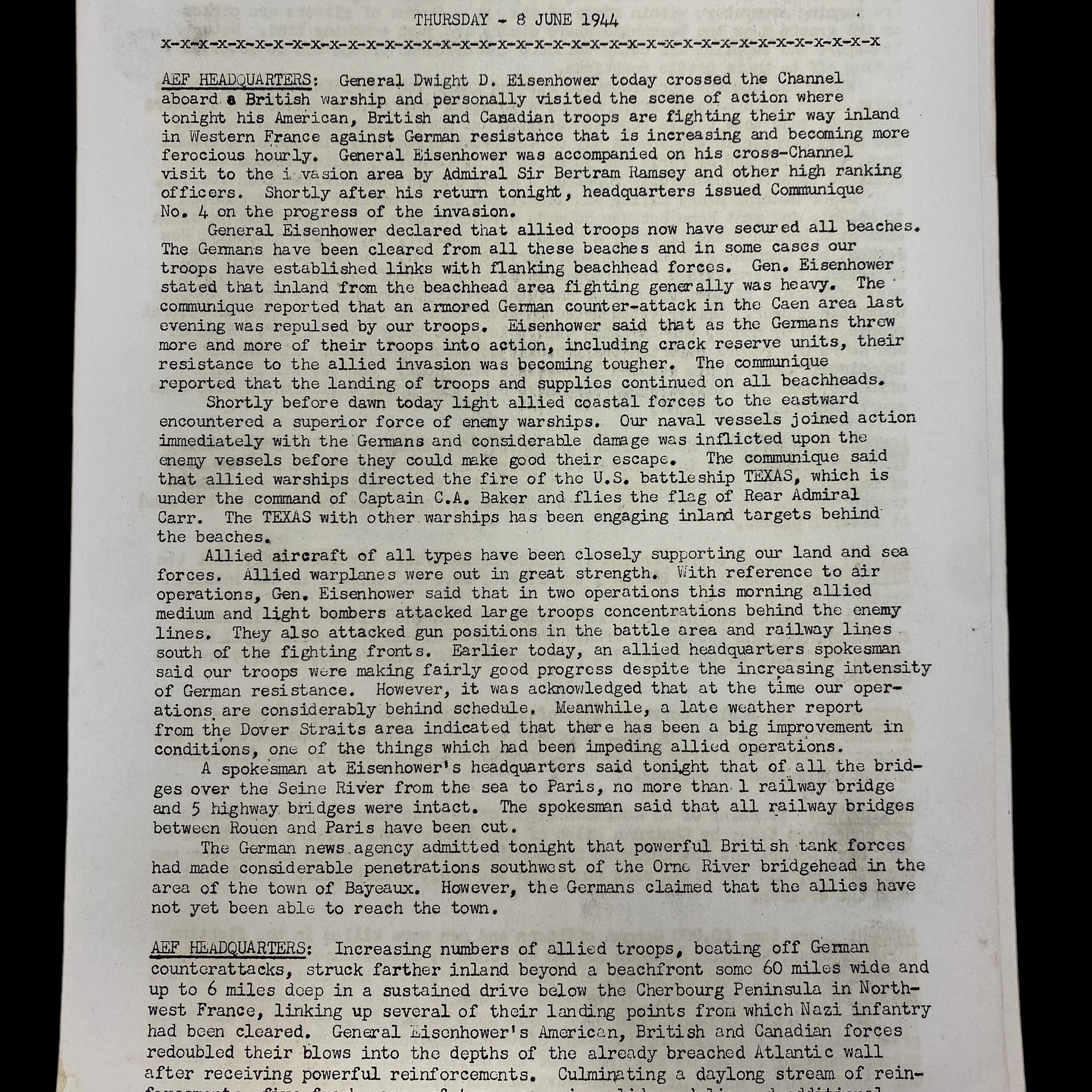
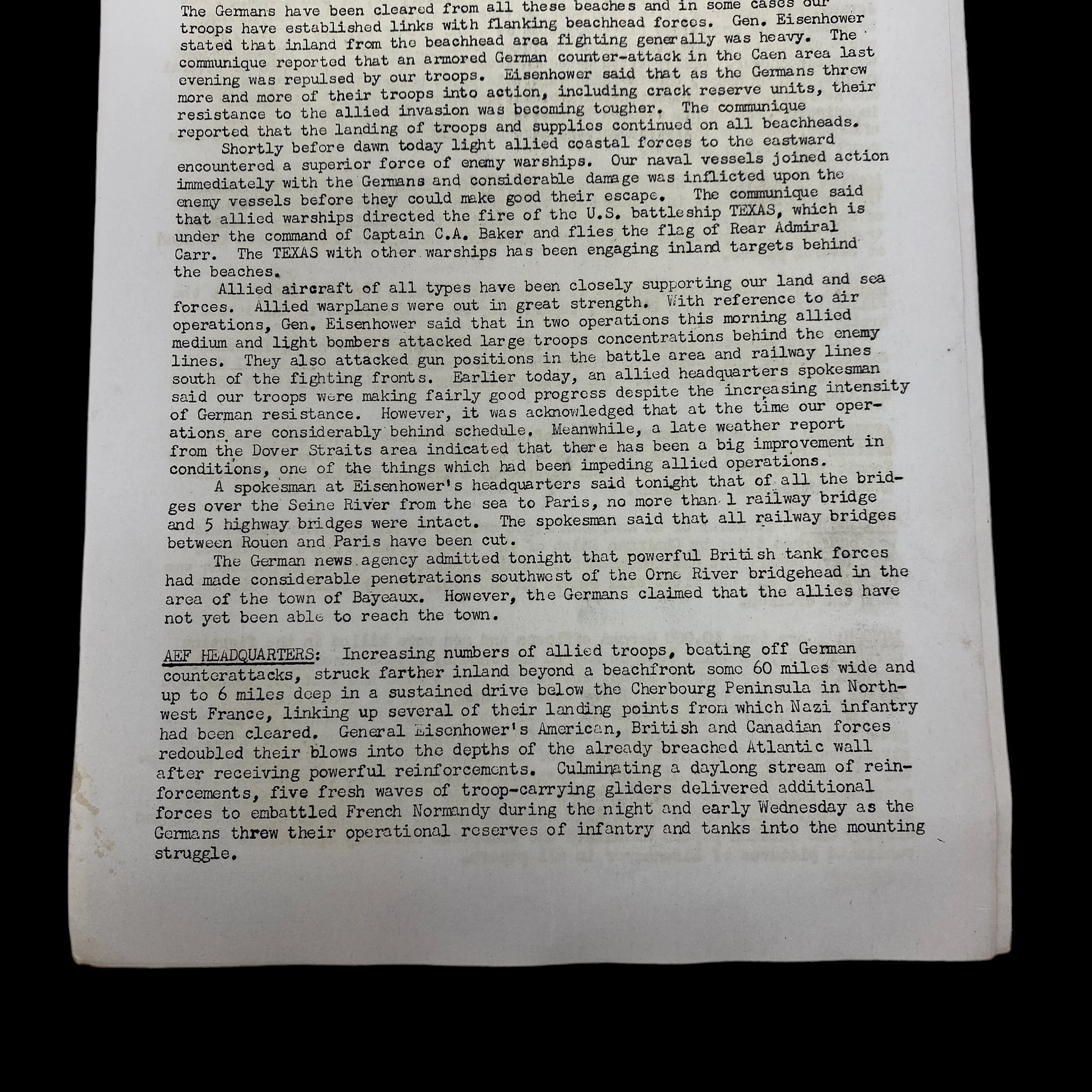


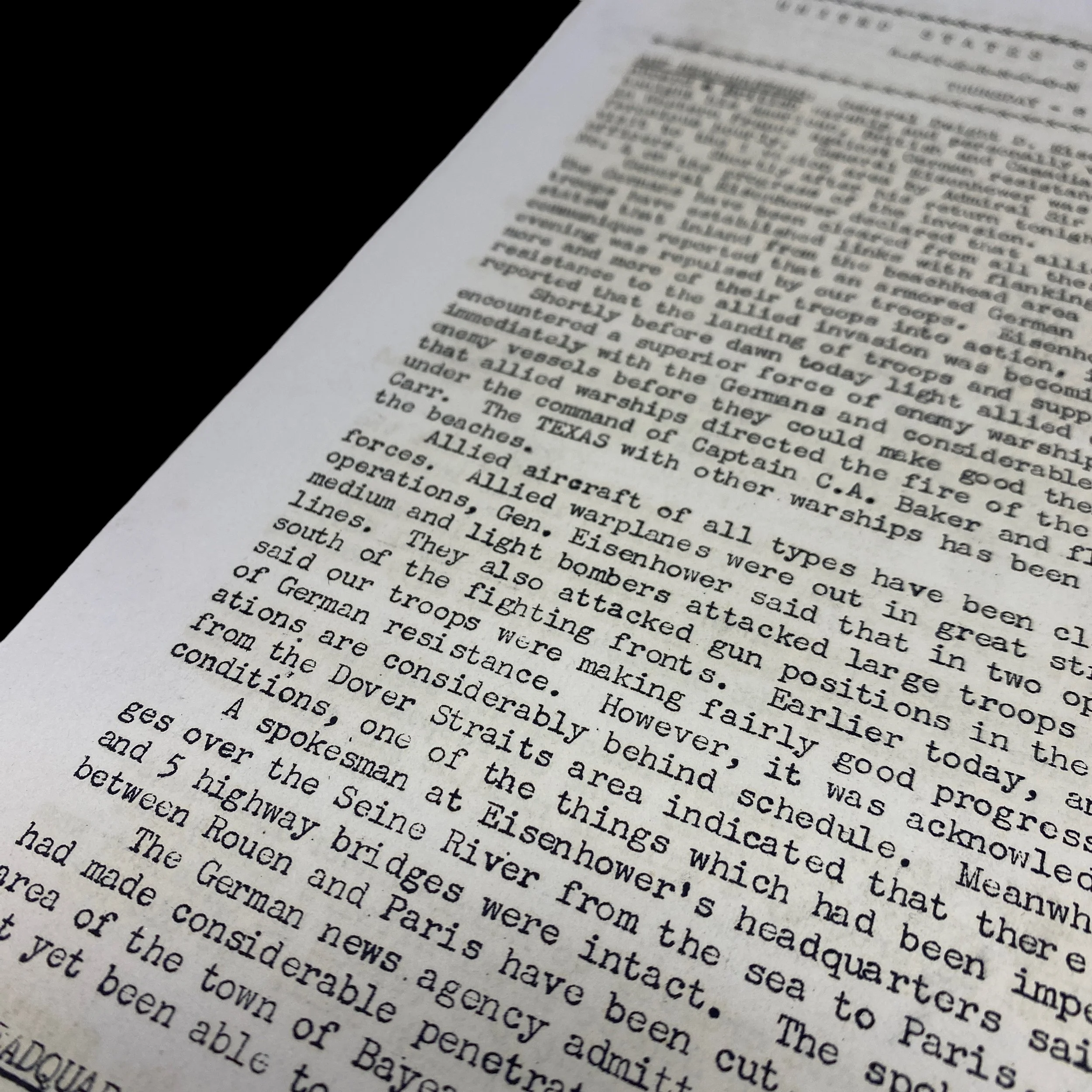
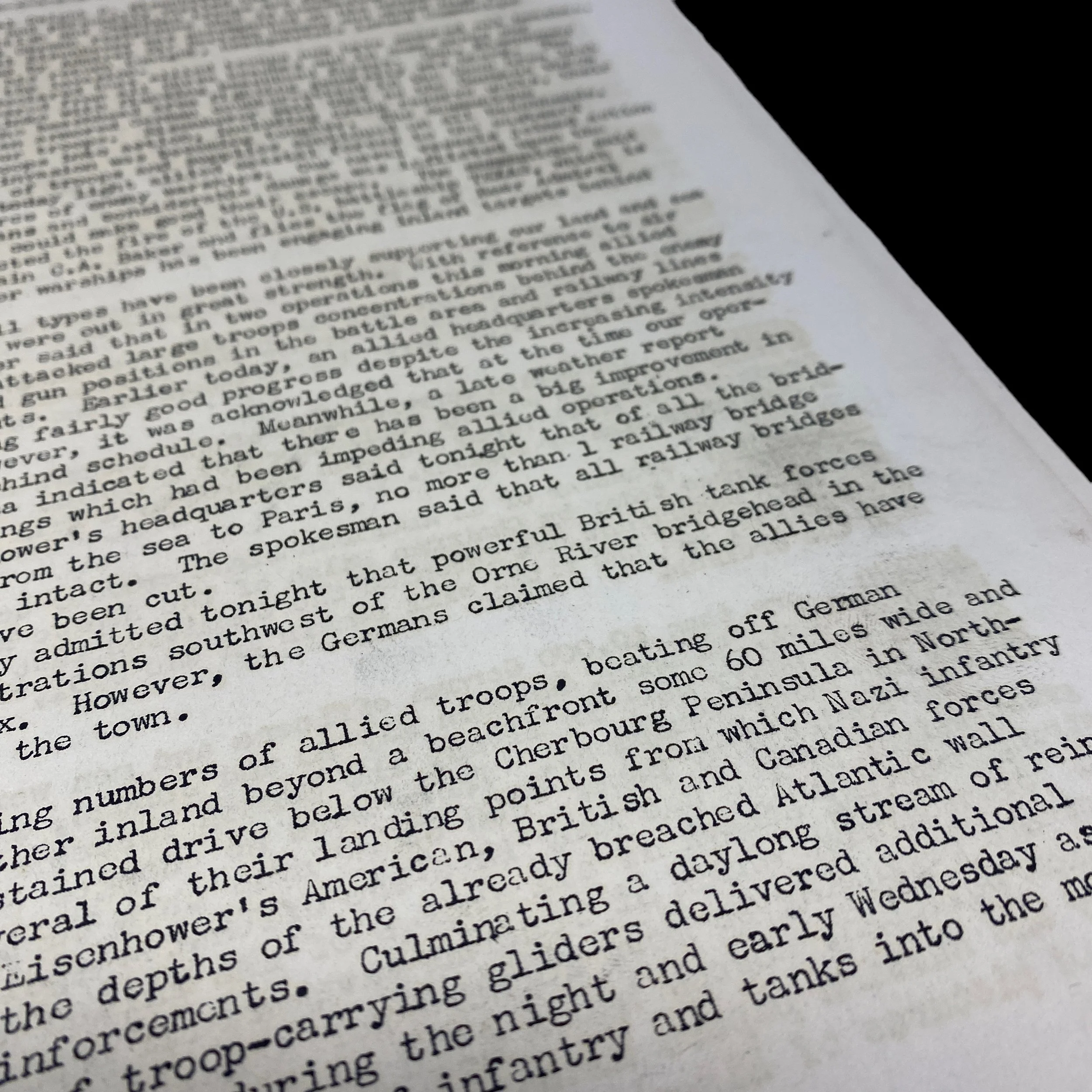



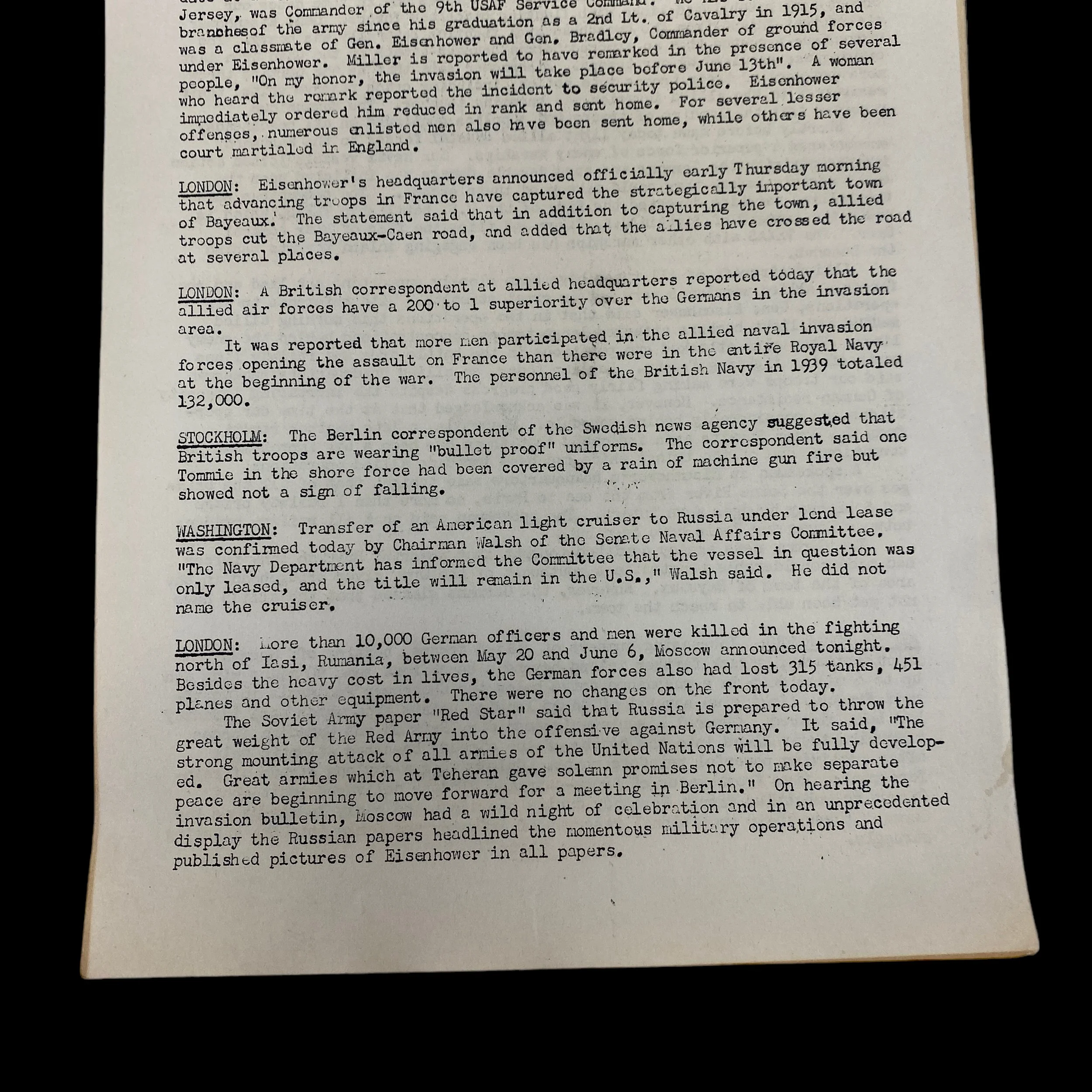



VERY RARE! WWII June 8th 1944 D-Day +2 Normandy Original Combat Invasion Report USS Minneapolis
Comes with hand-signed C.O.A.
*The intelligence report details General Dwight D. Eisenhower crossing the English Channel after the Allied beachhead landings on Omaha Beach, Utah Beach, Sword Beach, Juno Beach, and Gold Beach. It is declared in the report that the Allies have fully secured ALL beaches in Normandy and are still facing heavy resistance inland. The report also details multiple combat engagements of the USS Texas.
This incredible and museum-grade WWII D-Day artifact is an original June 8th, 1944 “SPECIAL WAR NEWS” printing D-Day +2 combat intelligence report detailing some of the first combat news of the Operation Overlord D-Day landings on the Normandy coast.
This multi-page combat report features incredible details of the attack including information on the U.S. Airborne operations where around 13,100 American paratroopers of the 82nd and 101st Airborne Divisions made night parachute drops early on D-Day, June 6, followed by 3,937 glider troops flown in by day. As the opening maneuver of Operation Neptune (the assault operation for Overlord) the two American airborne divisions were delivered to the continent in two parachute and six glider missions.
This would make an amazing edition to any WWII or D-Day collection.
AIRBORNE OPERATIONS
A massive airborne operation preceded the Allied amphibious invasion of the Normandy beaches. In the early hours of June 6, 1944, several hours prior to troops landing on the beaches, over 13,000 elite paratroopers of the American 82nd and 101st Airborne Divisions, as well as several thousand from the British 6th Airborne Division were dropped at night by over 1,200 aircraft. Almost 4,000 more paratroopers would later be brought in by gliders, known as Waco Gliders, during daylight hours. In total 23,000 paratroopers and glider troops would be used in Normandy. They were all to land inland, behind the main line of German defenders on the beach, and were given the job of taking the town of St. Mere Eglise and securing key approaches to the Allied beachhead.
While the operation was underway, heavy anti-aircraft fire from German guns in the trees and fields below, destroyed a number of the C-47 Skytrains (the transport aircraft used to deliver the paratroopers). The flak also forced the planes to evade and forced many off target, leading to most of the C-47s dropping their sticks of paratroopers at the wrong time and location. Also, in an attempt to avoid the flak, the C-47 pilots tended to not slow down to the proper speed for the troopers to exit. As a result, many of the paratroopers had their weapons or other pieces of equipment ripped off their person as they leapt into the prop blast behind their aircraft’s engines. The situation became even more chaotic as German machine guns targeted planes and floating paratroopers alike. One paratrooper, as he descended, ended up having his parachute snag on a church steeple. He was left hanging in midair, and was forced to play dead for two hours as the Germans moved around beneath him.
Scattered all over Normandy, the paratroopers began to slowly link up with one another and conduct their missions. These small bands, affectionately known as LGOPs by today’s airborne community, or Little Groups of Paratroopers, wreaked havoc on the German rear areas, often destroying German forces wherever they were encountered. The Germans stubbornly resisted, but were unable to monopolize on the chaos. They became engaged with paratroopers in many small actions, and ferociously defended pre-established strongpoints. These strongpoints were systematically destroyed by the paratroopers throughout the remainder of the week. The paratroopers captured St. Mere Eglise and were successful in securing most of their objectives, but it took them the better part of a week to successfully block a few of the causeways leading to Utah Beach even though that was an early objective.
NAVAL BOMBARDMENT
Besides the large airborne operation, the actual landings on the beaches were also to be preceded by a massive naval bombardment of the German coastal defenses. The largest naval bombardment ever seen at the time was to begin at 5:50 A.M. on D-Day. Though the navy wanted the bombardment to last for two hours, the army’s desire to limit the amount of time the Germans had to reinforce the beach positions restricted the bombardment to forty minutes. The battleships USS Arkansas, USS Nevada, a resurrected veteran of Pearl Harbor, and USS Texas each used fourteen inch guns that could launch explosive projectiles the size of small cars accurately to a range of fourteen miles. They were the main muscle of the American bombardment. However, these battleships were also supported by several cruisers and twenty destroyers. Together they shelled the gun emplacements and defensive positions on and around the American Beaches.
The British Royal Navy, using a very similar group of ships, shelled the defensive positions on and around their designated beaches as well. The bombardment was largely effective at neutralizing the German coastal guns, which failed to score a single hit on any allied ship, but failed to focus on the German pillboxes and fortified positions guarding the beaches. The ships continued to shell targets even after the landings began, and would be used, after the beachhead had been established, by ground forces as naval artillery support. The heroes of the bombardment, however, were the destroyers, who without orders, moved in, braving fire from beach defenses, and engaged targets of opportunity on the German-held beaches. Despite their importance, the efforts involved in the naval bombardment, as well as the airborne operations, were only support actions, and would not win the battle of D-Day alone. The landings on Normandy’s beaches would be where the battle was truly won or lost.
AMERICAN BEACHES
Utah:
The German defenses on Utah Beach included stakes, hedgehogs (large steel barriers created to prevent the movement of ships, tanks and infantry), barbed wire, antitank ditches, and mines. Portions of three German units defended the beach – the 709th, the 243rd, and the 91st Infantry Divisions. Of these, one battalion defended the beach and another was in support further behind. Beyond the beach were pillboxes (concrete fortifications), tank turrets, and trenches. At a distance of 1-2 miles from the beach were several coastal and artillery batteries.
The Americans divided the Utah beach landing into three zones: Tare Green, Uncle Red, and Victor. The operation was the responsibility of General Lawton Collins, under the command of General Omar Bradley. Five hours before the beach landings, paratroopers of the 101st and 82nd Airborne Divisions landed behind the beach’s fortifications to secure travel routes and destroy bridges. As they were securing roadways, Generalleutnant William Falley, commander of the German 91st Division, was travelling back to his headquarters, when he was shot and killed by paratroopers. This was the first beach to see a landing, and as the sun began to rise, the men of the US VII Corps began to make their way to shore. The 2nd Battalion, 8th Infantry Regiment made up the first wave, arriving at 6:30 A.M. The 1st Battalion, 8th Infantry Regiment made up the second wave, arriving at 6:35 A.M. on Tare Green and Uncle Red. The third wave comprised Sherman tanks that were designed to float across the water from their landing crafts all the way to shore.
Due to strong currents, the three waves landed 2,000 yards south of Utah, forcing them to march that distance back to the intended landing areas to seize the German fortifications. Although the beach was secured by the end of the day, not all of the objectives were met since they had to march to the correct beach. Success came at the cost of about 197 casualties of the 21,000 that landed at Utah on the first day, with an additional 2,500 casualties out of the 14,000 that had parachuted behind the beach.
Omaha:
The German defenses on Omaha included three defensive lines before the beach: iron gate structures with mines, followed by heavy stakes positioned at a slant with mines on top, and the final line was made with hedgehogs. Behind the beach were antitank ditches, and many strong points established on the cliffs behind. In addition, about three miles to the west was Pointe du Hoc, where an artillery battery was located, which provided a strong defense of the western flank of the beach. With more barricades along the beach and elevated terrain surrounding the area and with strong concrete structures, these fortifications were made more formidable than those on other beaches. The Germans had been well aware of the importance of the sector designated Omaha, which the Allies would need to connect and secure the beachheads together. Omaha would be the bloodiest of the landings due to these fortifications and terrain.
Omaha was more heavily defended than the Americans had expected, resulting in it becoming the bloodiest of the beach landings. Portions of two German units defended the beach – the 352nd and the 716th Infantry Divisions. The Americans divided the Omaha landing into eight zones: Charlie, Dog Green, Dog White, Dog Red, Easy Green, Easy Red, Fox Green, and Fox Red. The operation was under the responsibility of US V Corps commander, General Leonard Gerow, who was under the command of General Omar Bradley. Omaha was the second beach to be landed on, and at 7:00 A.M., the men of the US 1st Division exited their landing craft. Due to sand flats that prevented the landing craft from getting closer to shore, these men had to wade through water that was up to their shoulders. Many of these men drowned, while others were killed by enemy fire, and those that made it were frequently far from the rest of their units. Few radios worked, as they had been exposed to seawater, and officers trying to reorganize their men were often shot.
Sherman tanks were supposed to support both flanks, but those on the right sank on their way to shore, while those on the left made it since their landing craft skippers brought them all the way to shore. Since many of the landing craft were unable to reach shore, most of the artillery pieces did not make it.
As the fighting continued, 150 US Army Rangers managed to climb Pointe du Hoc, only to discover that the guns there had been removed. As nightfall came, the men began to infiltrate the cliffs behind and the beach began to reach a level of order, although it would remain vulnerable to counterattack. Success came at the cost of about 3,000 casualties of the 43,250 men that landed on Omaha the first day.
BRITISH AND CANADIAN BEACHES
Gold:
The Germans had heavy defenses on Gold Beach with machine guns, mines, and barbed wire, and also the 726th and the 716th regiments of infantry. In order to tackle this defensive network, the British divided the Gold landing into four zones: Item, Jig, King, and Love. This operation was led by General D.A. Graham. The 231st Brigade would lead the charge onto Jig, and 69th Brigade would assault King. On the day of the attack, seven hours before the infantry landed, the RAF and USAAF bombed the beaches hoping to weaken the defenses. H-Hour was set for 7:30 A.M., and the British soldiers boarded their landing craft to make the assault. The trip to shore was a 5000 meter voyage, and with the rough swells and wind, many of the British soldiers became sick. However, the men kept to their task and the first group to land was the Assault Engineers who were to clear all mines and obstacles. Seven minutes after they landed, the assault battalions were hitting the shore. The moment the men landed they began to take casualties, but the men continued to push forward by clearing German positions. The British were able to secure Gold Beach with the help of artillery, tanks, and air support. However, this success came at a high cost, and of the 25,000 who landed at Gold the first day 413 men were either listed as wounded, killed or missing.
Juno:
The British named the beach between Courseulles and St Aubin, Juno Beach. German defenses here were actually lighter because they did not think the Allies’ landing craft could make it past the offshore rocks. However, the Germans still placed mines and put the 2nd/736th Grenadier regiment in charge of defending the beach totaling 8,500 German defenders. Also, the beach was supported by 16 artillery pieces placed in pits near the coast. The Canadians of the 3rd Division were tasked with taking this beach and were led by Major General R.F. L Keller. Prior to their assault, the RAF and USAAF bombed the German positions. What sets this landing apart from the others is that the 6th armored regiment would be the one leading the charge. At 8:05 A.M., the men and tanks set out towards the beaches, but rough seas cost the attackers eight tanks. Those that made it to shore were hit with machine gun and artillery fire. Another problem that the Canadians encountered was the rising tide, which set their landing craft on German mines. As the men and tanks came ashore at Bernieires and Widerstandsnester,they encountered heavy German resistance and were only saved by naval gunfire. The Canadians pushed the Germans out and secure a beachhead and by 2:45 P.M. General Keller gave a press briefing atBernieres on the success of the operation. The Canadians landed 21,400 men and 3,200 vehicles on the first day, but the operation resulted in 946 casualties of those 335 were killed.
Sword:
Sword Beach was located between St. Aubin-sur-Mer and the mouth of Orne River. The Germans were able to use the rocky beaches and soft mud to their advantage. The Germans also employed interlocking artillery fire and had the beach zeroed in. The objective for Major General Rennie and his British 3rd infantry division was to not only take the beach, but also link up with airborne troops who landed east of the Orne River. The attackers were supported by two battleships, the HMS Roberts andRamilies, and were waiting for firing orders once the British landed on the beach. Prior to the landing at 5:45 A.M., the Allies bombed the heavy artillery pieces at Villerville. After the initial bombardment, the tanks and men of the 8th Brigade were given the signal to land. Even though German positions were hit by artillery and naval fire, they hunkered down and waited for the attacking British. East Yorkshire took 2,000 casualties within the first minutes. However, by 9:30 A.M. the reserve from Suffolk were landed and order to clear Coleville and head over to Morris by 1:30 P.M.
As the British established a beachhead, the Germans launched a counterattack at 4:00 P.M. They were supported with tanks and were able to reach the sea at Lion-sur-Mer. However, the main British force had been successful and this did not stop them from establishing a stronghold on the beach. The British fought valiantly and by the end of the day the British stopped three miles from their intended objective at Caen. In all, the British landed 28,845 men on the first day, but at a cost of 426 casualties.